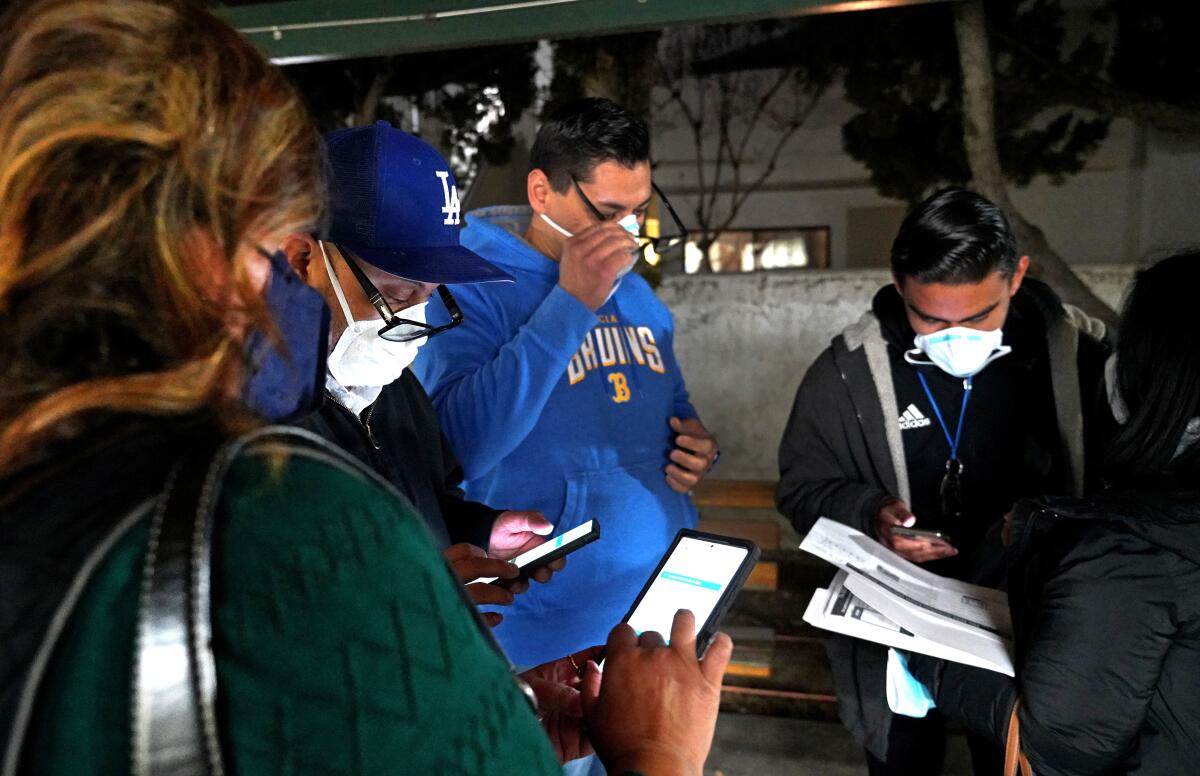No, homeless people are not everywhere. Just ask someone counting them

- Share via
For the last two years of the pandemic, Los Angeles residents have complained of more and more homeless people camped on sidewalks and beach boardwalks, in parks and business doorways.
Has the homeless population gone up? Or is it just more visible at a time when public health guidance advised against forcing homeless people to move from one sidewalk to another? Now that the Los Angeles Homeless Services Authority is conducting its annual three-night homeless count — its first in two years — we will get a definitive answer soon to that question.
But as a volunteer on Tuesday, the first night, I can tell you I found no homeless people in the portion of Sherman Oaks that I was assigned to count. Not one.
That doesn’t mean the unhoused population in L.A. has decreased or that some sidewalks in some parts of the county are not inundated with homeless people. But it does mean homeless people are not living everywhere — or always within sight of residents.
In the dark of Holly Park, the three of us walk around the baseball field, winding our way past the arc of concrete bleachers, flashlights in hand, scanning the landscape for homeless people who may have bedded down for the night.
The homeless count resumed this year with COVID-era protections for the expected 4,780 volunteers who signed up, according to the L.A. Homeless Services Authority, to drive and walk most of L.A. County looking for homeless people. The Homeless Services Authority is obligated to do this count to qualify for funding from the U.S. Department of Housing and Urban Development.
Volunteers are required to wear masks in deployment centers, where they receive flashlights and reflective vests and are assigned to census tracts. Training is conducted online through videos, and instead of marking paper tally sheets, volunteers use a phone app to mark the location of a homeless person — or a tent, vehicle or makeshift shelter judged to be refuge for a homeless person. Volunteers go out in teams and are urged to arrive in ready-made teams of friends or family.
While my friend and I lined up with others to get our census tract assignments at a hall in Church of the Chimes in Sherman Oaks, we were serenaded by the unexpected sounds of tap dancers practicing a routine on a stage behind a drawn curtain. (Loved it.)
Once in the car, my friend and I drove past blocks of apartment buildings and down quiet residential streets of houses in the San Fernando Valley. We drove past Mr. B Smokes and Lounge on Woodman Avenue and into a small shopping strip, where we got out and looked for signs of people wrapped in sleeping bags or sheltered by tents (or anything else) who might have embedded themselves near a dumpster or a set of stairs. I couldn’t imagine how any of the bare, exposed concrete I saw offered adequate shelter on this cold night when temperatures were in the high 40s.
We have just begun our night counting homeless people in Mar Vista when we do something a little creepy.
Bus shelters and benches were empty. In a cul-de-sac that ended at a grassy hill, we spotted something that looked like it might be part of a camp. It was an upended sofa that looked more discarded by a resident than found by a homeless person.
I thought of what Darry Sragow, the longtime political strategist who led research from recent focus groups on homeless people, told an L.A. Times reporter recently: “You go to the store, you go to school, you go to work, and there they are, they’re everywhere.”
Not in this corner of Sherman Oaks, I thought. A shopping area with plenty of little door fronts where homeless people might gather was empty — perhaps because the bright fluorescent white lights in the parking lot pulsated continuously in a jarring fashion.
Continuing on, we drove down a residential alley to a dead-end. When we reached it, lights came on from a side wall and a blaring siren sounded. I quickly turned the car around and got out. Maybe people had made their commercial districts and alleys as inhospitable as possible to thwart homeless people or anyone who wanted to lurk.
I know that my experience in Sherman Oaks is not an indicator that the homeless population of Los Angeles has plummeted. There are tens of thousands of homeless people in the city and the county overall and probably in greater numbers than were counted two years ago. But just being out there on a cold night — with bright blinking lights in parking lots — reminded me of how grim things are for those who live outside.
More to Read
A cure for the common opinion
Get thought-provoking perspectives with our weekly newsletter.
You may occasionally receive promotional content from the Los Angeles Times.











